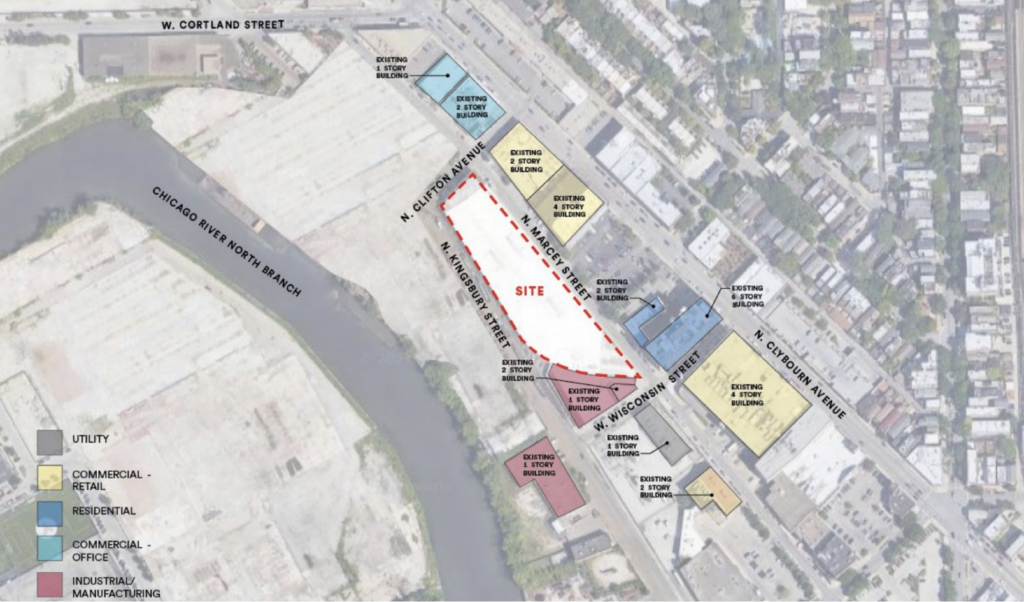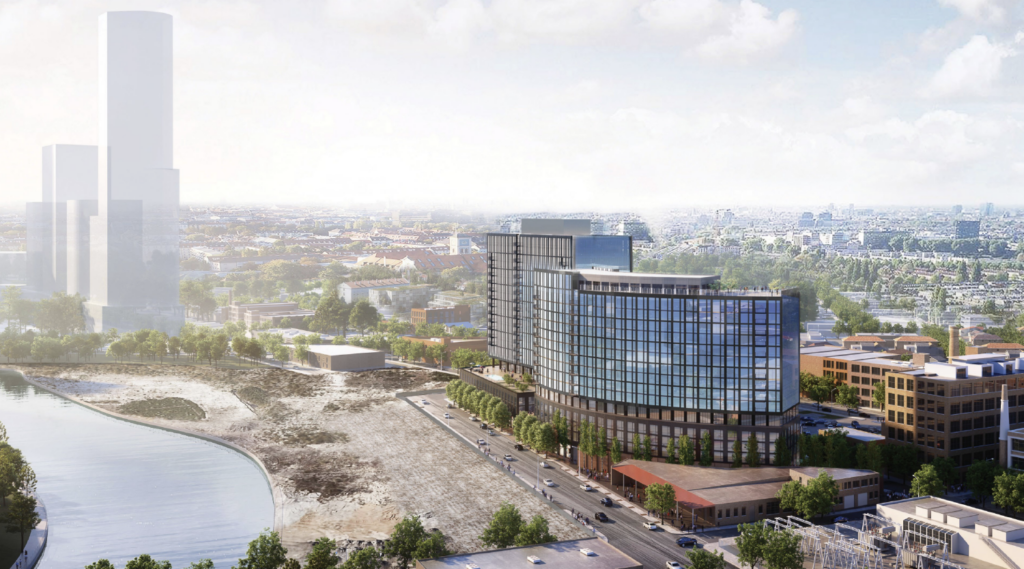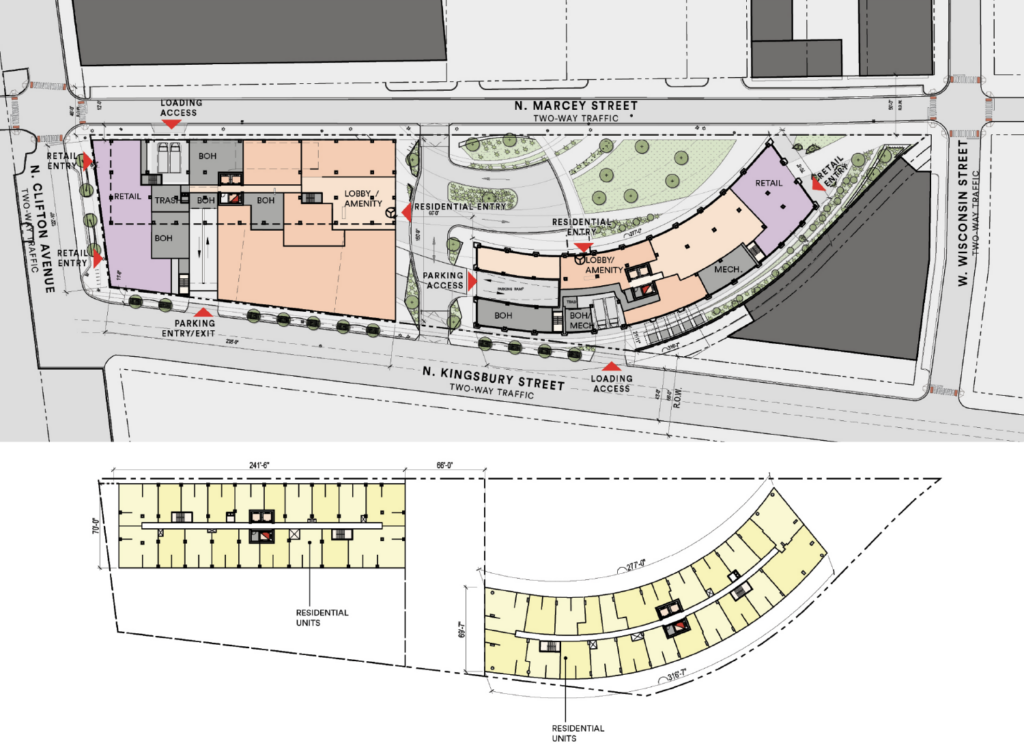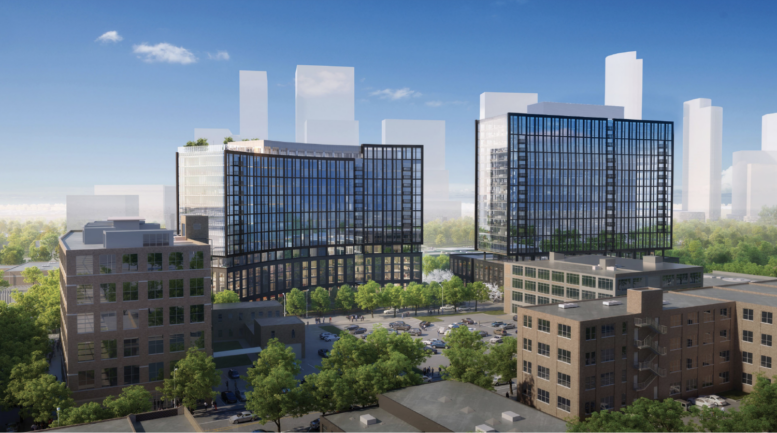Updated details have been revealed for the mixed-use development at 1840 North Marcey Street in Lincoln Park. Located just south of the upcoming Foundry Park and across the river from what remains of Lincoln Yards, the project has been tied up in the city approval process for over a year—culminating in a heated exchange last December.

Site context of 1840 N Marcey Street by SCB
Now, developer Sterling Bay has gained initial approval from the Committee on Zoning for its downsized plans. This came after the developer bypassed aldermanic approval and went directly to the city, with Alderman Waguespack dropping his opposition to the project. The plans will still require final approval from City Council.

PREVIOUS rendering of 1840 N Marcey Street by SCB
However, to make the project financially viable, Sterling Bay is still seeking to rezone the area as a low-affordability community. This will require a separate vote and would grant the project a significant tax break. Sterling Bay claims this is the only way to meet the 20 percent on-site affordable housing requirement. It’s worth noting that most projects do not pursue this designation.

PREVIOUS floor plans of 1840 N Marcey Street by SCB
Designed by local firm SCB, the two-tower project has been scaled down for the third time since its original proposal. Previously planned to rise 15 and 25 stories, the approved towers will now stand at 16 and 19 stories. This revision also includes a major reduction in parking—from 275 to 147 spaces—which will be located in an underground garage and within the towers.

PREVIOUS rendering of 1840 N Marcey Street by SCB
The ground floor will still feature various retail spaces and a small public park. The towers will now contain a total of 590 residential units, a slight decrease from the originally proposed 615. While the exact unit breakdown is unknown, 118 of them will need to be affordable. Residents will also have access to rooftop decks and a variety of amenity spaces.
The hotly debated proposal will now continue moving through the approval process. However, at this time, no timeline or financing details have been announced.
Subscribe to YIMBY’s daily e-mail
Follow YIMBYgram for real-time photo updates
Like YIMBY on Facebook
Follow YIMBY’s Twitter for the latest in YIMBYnews


if the alderman wants something in line with the surrounding area the developer should build a vacant lot
lol
These alderman are killing construction
You are incorrect.
No
What is a “low affordability community”? What does this mean for the neighborhood? Will it reduce their taxes at the expense of the rest of the community?
Basically I believe the will pay less property tax.
A Low Affordability Community in Chicago isn’t just about zoning—it’s a legal designation that:
Captures areas with low affordability or Downtown zones,
Enables 30-year phased tax exemptions for developing affordable housing, and
Amplifies ARO’s requirement for affordable unit inclusion.
If you do x% (20% for this break) then you get a certain tax reduction for 3 years, and another tax deduction for the next 27 years. Its meant to pay for affordable housing and is significantly cheaper than when the city builds AA itself.
This area would still be very wealthy regardless. It would not be “at the expense of the rest of the community” at all
This is a good example of how affordability requirements are effectively a tax that kill otherwise viable projects. Ironically harming affordability across the city.
I don’t doubt that Sterling Bay is also being greedy, and who knows the dynamics for this specific case. But writ large the point stands.
You’d be greedy too if you were looking down the barrel at having to pay off a mortgage in the amount of several hundred million dollars. You’d want all the margin you can get to pull that off through the kinds of changes the world throws at such things.
“low affordability community” means Sterling Bay gets a huge tax break while us homeowners/property owners get to pay what Sterling Bay doesnt have to. Sterling Bay-your company is falling apart – if you cant build things without having homeowners in chicago pick up your tab-get out of the business.
Yes – but this tax break is far, far cheaper at providing affordable housing compared to the city actually building affordable housing. For the city to build 118 affordable units, it would cost ~$100M which is no where near the NPV of the tax breaks coming in on this building. Additionally, having affordable housing with standard housing is a far better mix.
Whether or not you support affordable housing – this is the more economical way to approach the current stance.
Separately, neoliberal economics would dictate that without this requirement for affordable housing, we could achieve X% more market rate housing at full tax rates (yielding Y% more annual city revenue) along with a Z% decrease in cost of housing for some defined area with the largest effect nearby. Correct policy could be estimated on a case by case basis, but it would be with some level of error. All this said – low tax comm is way better than the city building housing
Any time a politician says they are going to lower the price of something (here, with affordable housing) you can be certain the price will increase.
That’s a very definitive statement that’s certain not to be true every time. It truly depends. But also, the lowest cost is not always the best outcome either.
Come on – if the project isn’t viable at the regular tax rates, then then it shouldn’t proceed. Sterling Bay knew about these rules BEFORE they bought the land. If the city does give the “affordability community” designation, it means that the tax burden falls on folks that do not have that designation. That is NOT fair.
The problem is they bought the land with the expectation that they were going to build at a certain density to recoup the costs. The people in the neighborhood along with the alderman forced them to reduce their density to unsustainable levels, so they had to get this tax deal to build anything. I’m sure interest rates and the tight lending market didn’t help, but now we have less housing AND we have to give a tax break because NIMBYs and their electeds have made it so difficult to build.
It helps that we’re building something but we could’ve had more if people thought about more than themselves and their misperceptions about property values.
The timeline alone for cost increases is enough to kill most projects in LA. People often underestimate the impact of delays on a project, forcing reductions AFTER gaining the support of investors while balancing all the city’s needs and other legislative requirements.
The Old Town kooks know precisely what they are doing with each lawsuit filed. Another one was thrown at the developer just this week for 1600 N LaSalle Drive.
When championing the cutting of red tape, that’s just one of the many steps we can take to support developers in achieving results. Next comes the financing and moving mountains to appease the most pathetic of NIMBYs.
You speak exactly like someone in the development game.
It’s SOOOO obvious.
If you’re so desperate to make $$ go build along the green line in all the thousands of empty lots near stations. TOD for thee!
Lol
Just like on the SF YIMBY boards. You folk just don’t get how supply and demand work. Austin is only a couple states away, yet their handle of prices FALLING is such a foreign concept. Get a grip.
Chicago is falling apart
Complete nonsense.
This whole saga has been dumb and taken way too long. But given how Sterling Bay has been absolutely incompetent in how they’ve handled every aspect of Lincoln Yards, I’m not willing to take the developer’s side over the Alderman’s in this particular instance.
Regardless of what you think about aldermanic prerogative, the current iteration of this project is much better (from a design, livability, and civic perspective) than the initially proposed version.
In what way is the downsized version better for any of those reasons?
Economically, it has brought this project to its knees, as the changes have left the developer begging for support. And if they don’t get the request of the tax adjustment, I doubt it will get built. And then what? Thousands (or millions?) would be wasted, time would be wasted, opportunities would be lost, and no new housing/future business patrons would be added to the neighborhood/city. We are one step away from absolute failure.
Massive decrease in parking is a huge win for the community. The City is not ready for Gen Z/Alpha driving patterns. People move to Chicago specifically because they don’t want to drive. I take issue with Ald. prerogative and don’t think this is massively better than the old proposal, but we should consider that a huge win as YIMBYs.
Sterling Bay bears all the responsibility here and the blame.
They continually bite off more than they can chew and then try to blame neighbors or Alderpeoples.
WE who live here AND actually pay taxes on our properties know the real deal.
Oh, and anyone crying about Waguespack stifling development/affordability is just a schill for these developers, glomming on to the housing movement for pure profit.
Looking at you Lionel Barrow.
“everyone I don’t like is a paid shill” or maybe we want the City to be making more than the approximately zero yearly property taxes the current lot is pulling? Or the gains of having hundreds of additional Chicagoans? This anti-growth mindset only makes sense if you are addicted to freezing the City in carbonite and killing our only chance at escaping financial ruin.
This is PURE CRAP!!!! AAAAAAAAAAAAAAAAAAAAAAAGGGHHH!!!
Actually it’s pretty nice. Built it, bro
Ughhhh…chop the height, make it wider with even a bigger shadow. NIMBY’s just don’t get it.
What are we going to do with that big patch of land right on the river?
Greenspace?
What are we going to do with that big patch of land right on the river?
Greenspace?
I think there may be a misconception about how the tax incentives work. They will get a reduction on the final assessment, but they will still be paying significantly more than what they are paying now. Unless a project creates significantly more costs to the City, almost any is a net fiscal positive. Not to get too far into the weeds, but most property taxes go to education, followed by emergency services and pension debt. This development will produce relatively few children and shouldn’t add much to emergency service costs. While they may not be producing as much tax revenue as they otherwise would, they will still certainly generate a lot more than they are now.
What are jobs will remain here after the development (of whatever size) is built? What non-construction related jobs will be part of this project? Will there be any “mid-level” rental rates, as well as subsidized apartments and luxury units? Appears there are no dedicated senior apts. included, OK, that’s for another project. Will there be amenities like a fieldhouse or a playground in the park? Did any of the designers and architects walk around these streets or stay in the ‘hood to get a “feel” for the surrounding areas of this new neighborhood to be built? * Construction supplies are very expensive, the tariffs are harmful to all construction and manufacturing budgets and budget projections. Insurance is up for every property owner in the country, this is easy to look up in the news online and from the insurance companies. Sterling Bay asking for the low affordability zoning is logical, it’s akin to what Habitat was doing with rehabs & remodels of older, good housing stock and getting the designation for ‘section 8’ subsidized housing. I used to live near there, I went to Prescott Grade School, Waller HS, I worked in the neighborhood. It’s too expensive for me for the last 30 years, c’est la vie. I’m happy to see the subsidies come in when they do and give a regular person (who isn’t rich) a chance to live in a good neighborhood with nice places to go. The neighborhood needs more jobs, too.
Build it!